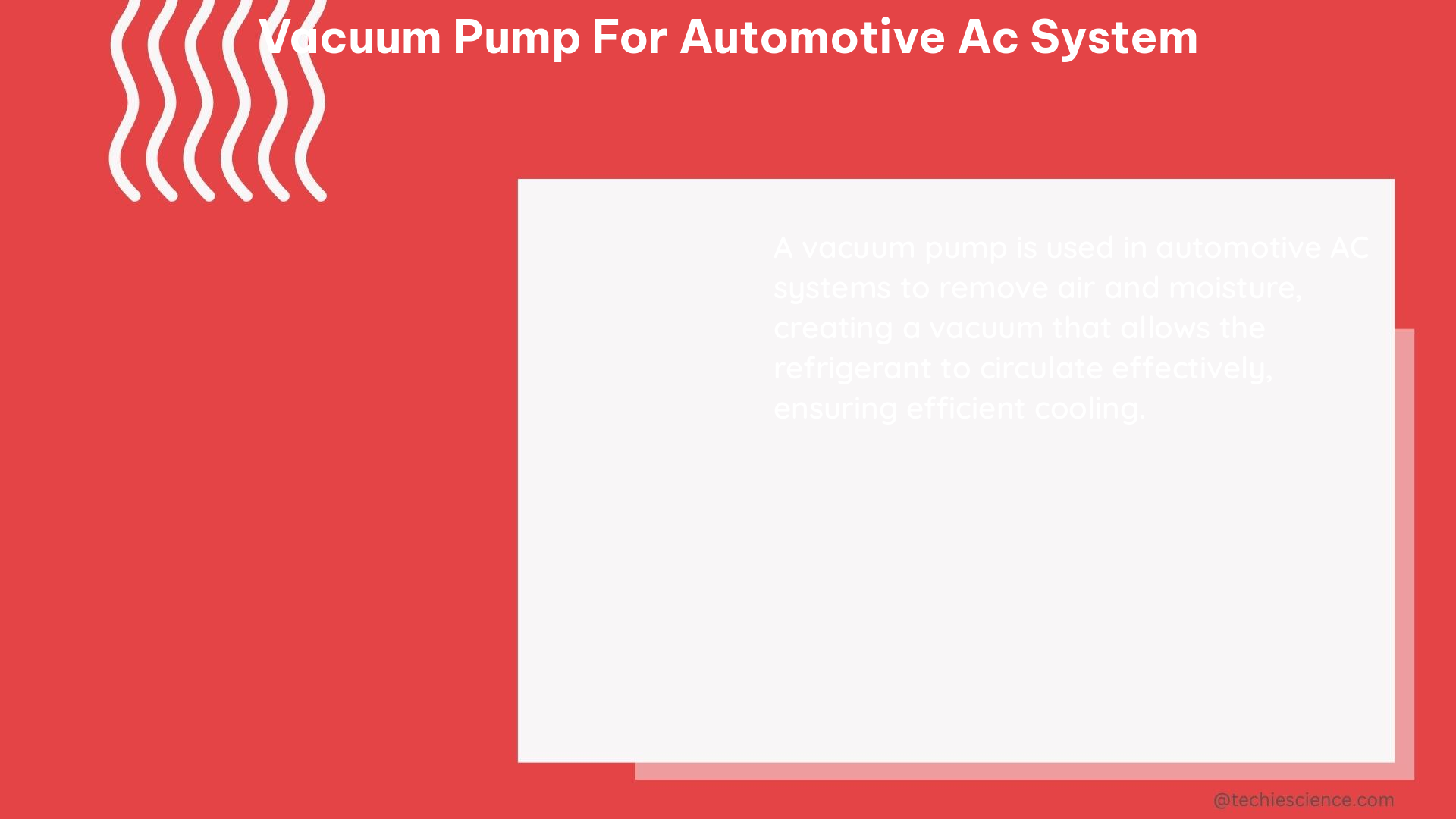A vacuum pump is a crucial tool for maintaining and servicing automotive air conditioning (AC) systems. It is used to remove air, moisture, and contaminants from the system before recharging it with refrigerant. This comprehensive guide will provide you with a deep understanding of the key specifications, best practices, and considerations for selecting and using a vacuum pump for your automotive AC system.
Understanding the Importance of Vacuum Pumps in Automotive AC Systems
Automotive AC systems rely on a delicate balance of pressure, temperature, and refrigerant to function correctly. The presence of air, moisture, or contaminants can disrupt this balance, leading to reduced efficiency, decreased cooling performance, and even system failure. A vacuum pump is used to create a deep vacuum in the AC system, which allows these unwanted elements to be removed, ensuring the system is properly prepared for recharging with fresh refrigerant.
Key Specifications to Consider When Selecting a Vacuum Pump

When choosing a vacuum pump for your automotive AC system, there are several critical specifications to consider:
1. Cubic Feet per Minute (CFM)
The CFM rating of a vacuum pump indicates the volume of air it can move per minute. For automotive AC systems, a pump with a CFM rating between 1.5 and 3 is typically sufficient. A higher CFM rating will allow the system to be evacuated more quickly, but it’s important not to oversize the pump, as this can lead to issues with oil carryover and potential damage to the AC components.
2. Single-Stage vs. Dual-Stage
Single-stage vacuum pumps are less expensive and simpler to use, but dual-stage pumps are more efficient and can reach deeper vacuums. For most automotive AC applications, a single-stage pump is adequate, as it can typically achieve the necessary vacuum depth of 29.9 inches of mercury (Hg) or lower.
3. Vacuum Depth
The vacuum depth, measured in inches of mercury (Hg), indicates the level of vacuum the pump can create. For automotive AC systems, a pump that can reach a vacuum depth of 29.9 inches Hg or lower is recommended to ensure thorough removal of air, moisture, and contaminants.
4. Power Source
Vacuum pumps for automotive AC systems can be powered by electricity or compressed air. Electric pumps are more common and easier to use, while compressed air pumps can be more powerful and may be preferred in some workshop settings.
5. Additional Features
Other features to consider when selecting a vacuum pump include oil-less operation, automatic shut-off, and portability. Oil-less pumps can be more convenient and require less maintenance, while automatic shut-off can help prevent damage to the pump if the system is fully evacuated. Portability may be important if you need to use the pump in different locations.
Best Practices for Using a Vacuum Pump in Automotive AC Systems
Properly using a vacuum pump for your automotive AC system is crucial to ensure the system is thoroughly evacuated and prepared for recharging. Here are the key steps to follow:
-
Prepare the System: Before using the vacuum pump, make sure the AC system is clean and free of debris. This includes removing any old refrigerant and oil, as well as checking for and repairing any leaks.
-
Connect the Pump: Securely connect the vacuum pump to the low-pressure service port of the AC system using the appropriate hoses and fittings. Ensure all connections are tight to prevent air leaks.
-
Evacuate the System: Turn on the vacuum pump and allow it to run until the system reaches the desired vacuum depth, typically 29.9 inches Hg or lower. Depending on the size of the system and the pump’s efficiency, this can take anywhere from a few minutes to several hours.
-
Hold the Vacuum: Once the desired vacuum depth is reached, hold the vacuum for a period of time, typically 30 minutes to several hours, to ensure that all moisture and air have been removed from the system.
-
Recharge the System: After the system has been properly evacuated and the vacuum has been held, you can then recharge the AC system with the appropriate type and amount of refrigerant, following the manufacturer’s instructions.
Safety Considerations and Regulations
When working with automotive AC systems and vacuum pumps, it’s essential to follow all relevant safety guidelines and regulations. This includes proper handling and storage of refrigerants, as well as the use of personal protective equipment (PPE) such as gloves and eye protection. Additionally, be aware of any local or national regulations regarding the disposal of used refrigerants and oil.
Conclusion
A vacuum pump is a critical tool for maintaining and servicing automotive AC systems. By understanding the key specifications, best practices, and safety considerations, you can ensure that your vacuum pump is used effectively and efficiently to keep your vehicle’s AC system running at its best. With the right knowledge and equipment, DIY enthusiasts can save time and money by servicing their own vehicles.
References:
- Residential AC Vacuum Pump vs Automotive AC Vacuum Pump
- Vacuum Pump CFM: Does it Matter?
- The Right-Sized Vacuum for Auto AC Work

The lambdageeks.com Core SME Team is a group of experienced subject matter experts from diverse scientific and technical fields including Physics, Chemistry, Technology,Electronics & Electrical Engineering, Automotive, Mechanical Engineering. Our team collaborates to create high-quality, well-researched articles on a wide range of science and technology topics for the lambdageeks.com website.
All Our Senior SME are having more than 7 Years of experience in the respective fields . They are either Working Industry Professionals or assocaited With different Universities. Refer Our Authors Page to get to know About our Core SMEs.